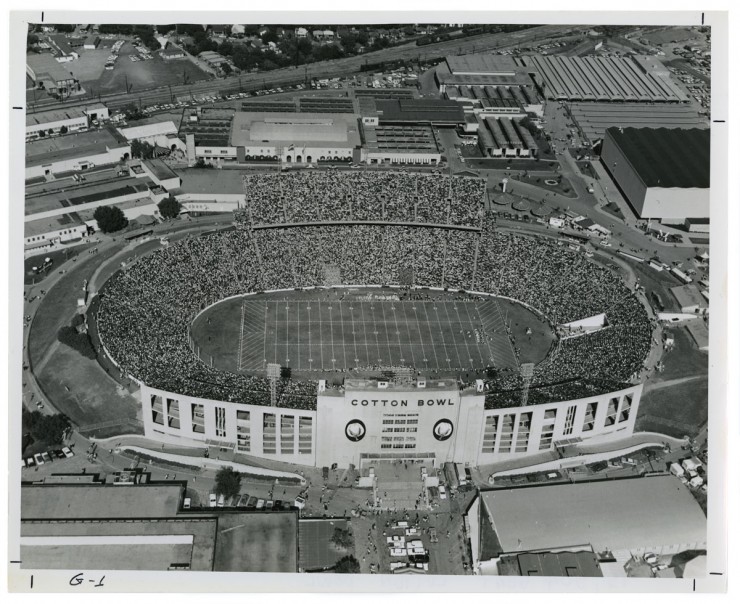
This aerial photograph shows the Cotton Bowl stadium in Fair Park filled with fans. From the Lester Strother Texas Metro Collection. UNTA_AR0327-101-002.
In the years following World War II, Doak Walker (a.k.a. “The Doaker”) was the college football favorite. A true All-American, Doak led the SMU Mustangs in academics, athletics, and leadership, leaving behind a solid legacy for all Mustangs to come. He entered Southern Methodist University as a Freshman in 1945 and led the Mustangs to Southwest Conference championships and Cotton Bowl appearances in 1947 and 1948. Fans across the metroplex were so enamored with Doak and his team that the school decided to move its games away from its home field to the Cotton Bowl, which quickly expanded its seating to meet the demands of spectators. In 1948, he won the Heisman Trophy, and he graduated in 1949. He joined the Detroit Lions in 1950, and was inducted to the Football Hall of Fame in 1959. An honorary plaque hangs at the Cotton Bowl’s main entrance that reads “The Cotton Bowl, the House that Doak Built.” To watch Doak Walker receiving a “Greatest College Football Player of the Decade” award, click here.
Doak Walker passed away in 1998, but the Cotton Bowl still stands at Fair Park in Dallas. In 1930, construction on the Cotton Bowl began to replace the old wooden Fair Park Stadium. The Cotton Bowl classic was played here until 2009, when it moved to the flashier, newer Cowboys Stadium in Arlington. The Dallas Cowboys also called the Cotton Bowl home from 1960 to 1971. The Red River Shootout, now known as the Red River Rivalry, is an annual football game between the University of Texas Longhorns and the University of Oklahoma Sooners. The game takes place during the State Fair of Texas and ticket sales are split evenly among the two schools. The Cotton Bowl was also a venue for the 1994 FIFA World Cup, and it has hosted the Dallas Independent School District’s football playoffs since 1974. To watch football highlights from a Chicago Bears and New York Giants game at the Cotton Bowl in 1956, click here. (Unfortunately, you’ll have to skip through a news story about a murder-suicide to get to the game.)
For those Texans that weren’t into football (admittedly, there are few), the Cotton Bowl offered musical excitement, as well. Elvis Presley attracted 27,000 fans to the Cotton Bowl in 1956, when he was just 21 years old. Aerosmith also recorded their first live album here in the late 70s, and other notable musicians like Bruce Springsteen, Heart, Journey, and Van Halen have played at this venue in Fair Park.
The sporting industry is one of the biggest industries in America, and it indirectly affects other areas of our economy that may not always be immediately evident, such as agriculture and transportation. An article in the January 1966 issue of the Texas Metro claims that the Cotton Bowl brought one million new dollars to the area every year. The Dallas Cowboys and the north Texas stadiums, like the Cotton Bowl, combined with the DFW Airport provide a lot of good to our part of the state.
The photograph of the Cotton Bowl comes from the Lester Strother Texas Metro Magazine collection. The Texas Metro was founded to publicize the Dallas-Fort Worth Airport and the many economic opportunities in the Southwest Metroplex. The collection includes 183 linear feet of articles and photographs from the magazine, as well as other grey literature.
-by Alexandra Traxinger Schütz



Joan Gosnell
Can’t have a story about the “House that Doak Built” without a photo of Doak! http://digitalcollections.smu.edu/cdm/ref/collection/bim/id/39
Fascinating story!
Alexandra
Thanks Joan for the photo of Doak! I’m glad you liked the story.